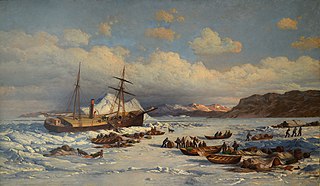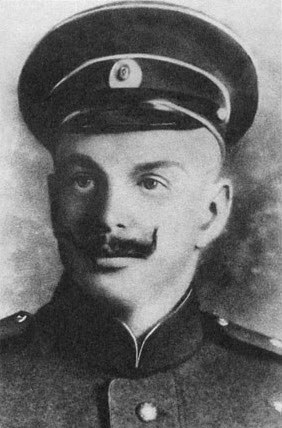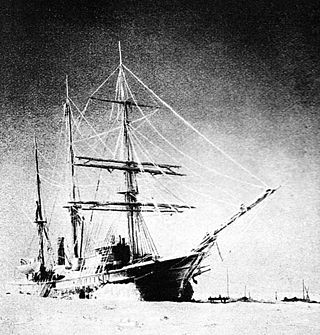The voyage
Sighting Greenland on June 20, the expedition made harbor at the Crown Prince Islands (Whale Fish) in Disco Bay. From a British mail ship, they learned that British relief efforts were heading for the same region. Advance and Rescue left the islands on June 29, [5] encountering the ice field on July 1, while proceeding towards Upernavik. By July 7, the pack ice was dense enough to compel the Advance to tow the Rescue to prevent the vessels from becoming separated. The crews were periodically sent onto the ice to 'bore' a passage by hand, using crowbars, ice anchors and boathooks. For 21 days the ships were held nearly fast, only heaved slowly forward by efforts of the crew.
Finally freed of the pack ice on July 28, the expedition sailed across Melville Bay, amid persistent ice bergs. As August began, food supplies were supplemented by hunting the returning auks and the occasional polar bear. On August 10, a wind change forced both ships to tie in and ride out dangerous pressure heaves as the ice closed in. After casting off to open water the next day, steady progress northward was made along the coast towards Lancaster Sound where they encountered Inuit hunters near Cape York, [5] at nearly 76° north. [4] Crews occasionally made short trips inland for hunting and observation.
Traces of Franklin
On August 18, the expedition made contact with British ship Lady Franklin under Captain William Penny, embarked on their own Franklin rescue mission. [4] News of other concurrent British expeditions was exchanged. On the 21st, they encountered the Felix, under the command of Sir John Ross. [6] On the 22nd, they met with Captain Forsyth aboard the Prince Albert, who suggested a joint sledge search of the lower Boothian and Cockburne lands. Discovery of a cairn left two days earlier by Assistance and Intrepid at Cape Riley, Devon Island, indicated that traces of British encampments had been found at the cape, and also at Beechey Island. [7] The Rescue under Captain Griffin, had shared in this discovery with Captain Ommanney.
At Cape Riley, remnants of stone walls were found, presumably to support Franklin's tents. Remains of cases from salted meat as well as articles of clothing and boat fragments were found. No previous expeditions were known to have camped here. De Haven observed that the ice of Wellington Channel had every indication of having remained unbroken for several years previous. [7] The joint team proceeded to Beechey Island on the 26th, meeting Captain Penny's ships Lady Franklin and Sophia. Penny was accompanied by R. Anstruther Goodsir, the brother of Harry Goodsir, an assistant surgeon missing with Franklin's group. Other remains, including containers with London labels, newspapers from 1844, and papers signed by Franklin's officers, were tracked from the cape. [4]
By now, the expeditions of Ross and Penny were in the area of the Advance and Rescue. Coordinated search plans were being made when a land party at Beechey Island reported the discovery of graves. The three graves were marked by traditional wooden markers and protected by slabs of limestone, facing Cape Riley.
Icebound
Winter storms soon separated the ships, including Rescue, which was driven south out to sea. The Advance made for the relative shelter of Griffith's Island, to be joined by some of the others. The Rescue had regained control to the south, and De Haven, judging that the expedition had not reached a point from which the search could be resumed, [7] decided to attempt a return of both ships home with the information gathered. The ice thickened, however, and the two ships were soon caught fast in Wellington Channel at roughly 75°24' north. De Haven named the mountains to the distant north "Grinnell Land", which was later determined to be a peninsula of Devon Island. [8] The heavy ice nipped at the vessels and the floe dragged both ships northward as seasonal darkness began to set in.
By October 1, the two ships were prepared for the long winter, with the upper decks covered, sails stacked and stove pipes set. An emergency depot of provisions was cached on the nearest shore. Periodically violent ice movements threatened both ships, which drifted north or south as dictated by the wind. Lard lamps kept the cabin temperatures just above freezing. Several crew members began showing early signs of scurvy, against which Kane hunted seals and foxes to provide fresh meat. Curious foxes were tamed to amuse the crew. Full winter preparations were completed by November 9, with the ships now in the vicinity of Beechey Island and temperatures generally below zero.
As December began, the crew made preparations for abandoning the vessels in an emergency, preparing supplies and readying sledges. The ice continued to grind the brigs. On December 7, dangerous conditions forced the desertion of the Rescue, with her crew brought on board the Advance. The Advance was lifted by the ice, and crews were periodically sent out to pry the ice away from the bow, while the vacant Rescue was being slowly torn apart just 50 yards (46 m) away. The floe continued drifting, now to the southeast towards new ice hazards in Baffin Bay. Griffin led the practice of evacuation drills and snow was packed around the Advance as insulation from the increasing cold. Eight of the crew now displayed the blackened gums of scurvy as morale declined in the perpetual Arctic night, despite an improvised Christmas theatrical.
The year 1851 began at the edge of Baffin Bay, with temperatures generally around −25 °F (−32 °C) as daylight began its return. On January 13, the ice activity increased amid fierce winds, and supplies cached on the ice were lost while the situation of the Rescue became more dire. The tedium of February was broken by occasional games of football on the ice, and more theatricals at night. The symptoms of scurvy advanced, and rations of fresh food were increased, but to little avail. On the 22nd, the coldest temperature of the voyage was noted at −53 °F (−47 °C).
As March began, the decision was made to refit the Rescue for service, including hull repairs in a drydock carved from the surrounding ice. The increased daylight, exercise and liberal rations of sauerkraut and lime juice began to reduce the symptoms of scurvy among the crew. The movement of the ice packs slowed, until the ships were held around 72° north. At mid-March, the ice began to break up and wildlife began to return amid heavy snows. April brought some open water as the crew began salting the ice around the two brigs. On April 22, the crew of the Rescue completed their return to their ship, surprised that the brig had survived the winter after all.
Breakout
By mid-May, efforts to weaken the ice at the ships with long saws began to show results as the ice floe approached Cape Searle. Slabs of ice were cut from the mass surrounding the ships and winched away. Fresh meat from bird hunting and an occasional polar bear strengthened the crews. The open water crept closer to the ships, but remained tantalizingly out of reach. The break-up of the ice flow finally released the ships on June 5, 1851, after drifting some 1,050 miles (1,690 km); [3] the stern of the Advance was still held aloft by a last large table of ice. Ice saws were used, but gunpowder for blasting could not be spared. These efforts were ineffective, as the ice also firmly held the rudder of the brig. This ice violently released the Advance on June 8, after which both ships made sail through a labyrinth of ice. They reached the Whale Fish Islands on June 16, and recuperated for five days with the Inuit at Godhavn before setting out north to resume their search for Franklin.
By June 24, they encountered the pack ice again and slowly made their way towards Upernavik. Hunting and visiting with the local Inuit passed the time until they harbored at a Danish settlement in early July. Setting out as the ice cleared, they encountered British whalers, exchanging news, mail, and fresh provisions before briefly visiting Upernavik. Nearby, they again met and joined forces with the Prince Albert, still searching for Franklin. The three ships made slow progress northward though the ice fields over the next weeks, before the way was blocked entirely. On August 5, the Prince Albert abandoned the situation, heading south through the pressing ice. Rescue and Advance continued their efforts to reach the search areas of the open waters of Wellington Channel as the summer season faded early. They slowly cut north, yard by yard, through the increasingly violent pack ice, as larger icebergs drifted in and calved still more loose ice. By August 17, they had pulled themselves to open water for the first time in nearly a month, and De Haven resolved to return home before winter caught them again. Upernavik was reached on August 23. They were met by Henry Grinnell at New York on September 30, 1851, to whom both ships were returned.

Willem Barentsz, anglicized as William Barents or Barentz, was a Dutch navigator, cartographer, and Arctic explorer.

Sir John Franklin was a British Royal Navy officer and Arctic explorer. After serving in wars against Napoleonic France and the United States, he led two expeditions into the Canadian Arctic and through the islands of the Arctic Archipelago, in 1819 and 1825, and served as Lieutenant-Governor of Van Diemen's Land from 1839 to 1843. During his third and final expedition, an attempt to traverse the Northwest Passage in 1845, Franklin's ships became icebound off King William Island in what is now Nunavut, where he died in June 1847. The icebound ships were abandoned ten months later and the entire crew died, from causes such as starvation, hypothermia, and scurvy.

HMS Resolute was a mid-19th-century barque-rigged ship of the British Royal Navy, specially outfitted for Arctic exploration. Resolute became trapped in the ice searching for the “Franklin Expedition” and was abandoned in 1854. Recovered by an American whaler, she was returned to Queen Victoria in 1856. Timbers from the ship were later used to construct the Resolute desk which was presented to the President of the United States and is located in the White House Oval Office.

Elisha Kent Kane was a United States Navy medical officer and Arctic explorer. He served as assistant surgeon during Caleb Cushing's journey to China to negotiate the Treaty of Wangxia and in the Africa Squadron. He was assigned as a special envoy to the United States Army during the Mexican–American War and as a surveyor in the United States Coast Survey.

The first USS Advance was a brigantine in the United States Navy which participated in an Arctic rescue expedition. Advance was built in 1847 as Augusta in New Kent County, Virginia and loaned to the Navy on 7 May 1850 by Henry Grinnell to participate in the search for Sir John Franklin's Arctic expedition which had been stranded in the frozen north since 1846. After last-minute preparations, the ship, under the command of Lieutenant Edwin J. De Haven and in company with Rescue, put to sea from New York on 23 May 1850.
Sir Alexander Armstrong was an Irish naval surgeon, explorer, naturalist and author. After obtaining a medical degree he joined the Royal Navy and was stationed on board HMS Investigator, tasked with finding the lost expedition of explorer Sir John Franklin. Investigator was trapped in the ice at Mercy Bay in 1851 and Armstrong spent several winters in the Arctic before he returned to London.

Hans Hendrik was a Kalaallit interpreter, Arctic explorer, and the first Inuk to publish an account of his travels. He was born in the southern settlement of Fiskenæsset.

The Polarisexpedition of 1871–1873 was one of the first serious attempts to reach the North Pole after that of British naval officer Sir Edward Parry, who reached 82° 45′ N in 1827. Funded by the U.S. government, the expedition's notable achievement was reaching 82° 29′ N by ship, a record at the time.

The first USS Rescue was a brig in service with the United States Navy.

Georgy Lvovich Brusilov was a Russian naval officer of the Imperial Russian Navy and an Arctic explorer. His father, Lev Brusilov, was also a naval officer.

Zarya was a steam- and sail-powered brig used by the Russian Academy of Sciences for a polar exploration during 1900–1903.

Vladimir Ivanovich Voronin was a Soviet Navy captain, born in Sumsky Posad, in the present Republic of Karelia, Russia. In 1932 he commanded the expedition of the Soviet icebreaker A. Sibiryakov which made the first successful crossing of the Northern Sea Route in a single navigation without wintering. This voyage was organized by the All-Union Arctic Institute.

Franklin's lost expedition was a failed British voyage of Arctic exploration led by Captain Sir John Franklin that departed England, United Kingdom in 1845 aboard two ships, HMS Erebus and HMS Terror, and was assigned to traverse the last unnavigated sections of the Northwest Passage in the Canadian Arctic and to record magnetic data to help determine whether a better understanding could aid navigation. The expedition met with disaster after both ships and their crews, a total of 129 officers and men, became icebound in Victoria Strait near King William Island in what is today the Canadian territory of Nunavut. After being icebound for more than a year Erebus and Terror were abandoned in April 1848, by which point two dozen men, including Franklin, had died. The survivors, now led by Franklin's second-in-command, Francis Crozier, and Erebus's captain, James Fitzjames, set out for the Canadian mainland and disappeared, presumably having perished.

Captain William Penny (1809–1892) was a Scottish shipmaster, whaler and Arctic explorer. He undertook the first maritime search for the ships of Sir John Franklin. In 1840, Penny established the first whaling station in the Cumberland Sound area on Kekerten Island.

The second Grinnell expedition of 1853–1855 was an American effort, financed by Henry Grinnell, to determine the fate of the Franklin's lost expedition. Led by Elisha Kent Kane, the team explored areas northwest of Greenland, now called Grinnell Land.

The McClure Arctic expedition, one of many attempts to find the missing Franklin expedition, was significant for being the first to successfully discover and transit the Northwest Passage, which it accomplished by both boat and sledging.

The McClintock Arctic expedition of 1857 was a British effort to locate the last remains of Franklin's lost expedition. Led by Francis Leopold McClintock, RN aboard the steam yacht Fox, the expedition spent two years in the region and ultimately returned with the only written message recovered from the doomed expedition. McClintock and crew were awarded the Arctic medal in recognition of their achievements.

Breadalbane was an 1843 British three-masted merchant barque that was crushed by ice and sank in the Arctic in 1853. Notable as one of the northernmost shipwrecks known, she is also considered one of the best-preserved wooden ships ever found in the sea due to slow deterioration in the cold Arctic water. Historically, Breadalbane is considered to be a time capsule.

Thomas Abernethy was a Scottish seafarer, gunner in the Royal Navy, and polar explorer. Because he was neither an officer nor a gentleman, he was little mentioned in the books written by the leaders of the expeditions he went on, but was praised in what was written. In 1857, he was awarded the Arctic Medal for his service as an able seaman on the 1824–25 voyage of HMS Hecla, the first of his five expeditions for which participants were eligible for the award. He was in parties that, for their time, reached the furthest north, the furthest south (twice), and the nearest to the South Magnetic Pole. In 1831, along with James Clark Ross's team of six, Abernethy was in the first party ever to reach the North Magnetic Pole.

















